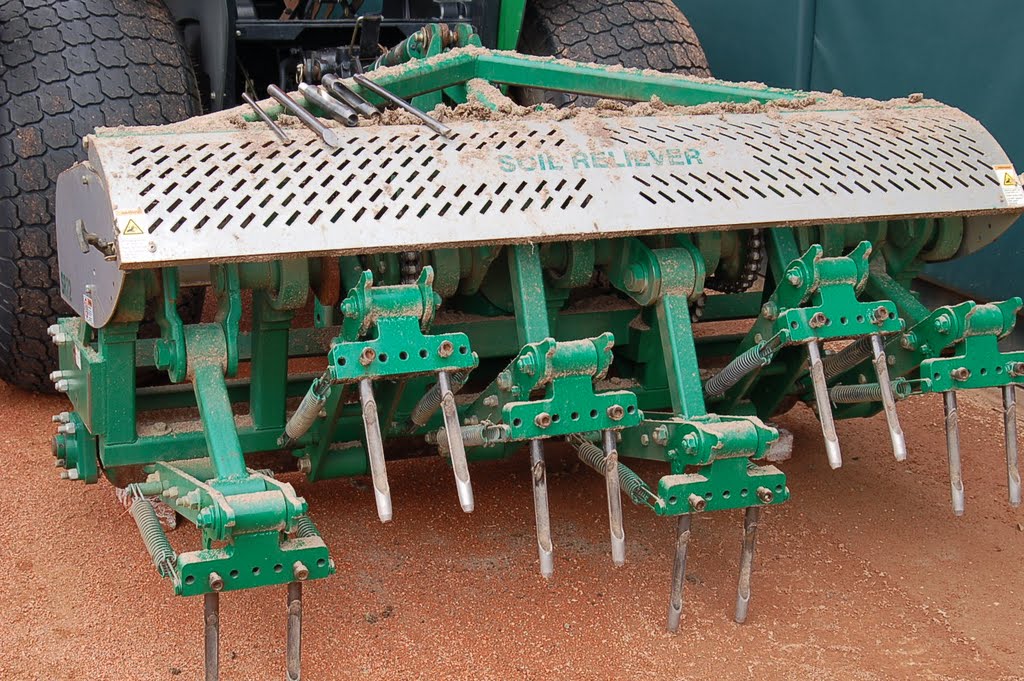 |
| Deep Tine Aerator |
If you are short of funds and personnel then my vote is to fund
core aeration of cool-season sports fields. There are many benefits besides relieving soil compaction to include getting more air and water into the root zone and helping decompose thatch which will also release more nutrients into the soil. Healthier turf grass from core aeration requires less fertilization, less pest control such as grab grass and broad leaf weed control, and less watering. The second most important consideration in the health of turf grass is cutting the grass at the same height more frequently and producing less thatch which acts as a valuable fertilizer (read more below on whether to cut the grass shorter early in the season).
(Courtesy of
Kansas State Horticulture Department)
"If you are planning to core-aerate your tall fescue or Kentucky bluegrass sports fields this spring, reserve a machine now so you can get the job done in March or early-April. Coring early in the spring gives cool-season lawns a chance to recover before crabgrass and other warm-season annual weeds start to germinate.
Core-aerating is one of the best things you can do for your sports fields. It relieves compaction, hastens thatch decomposition, increases water infiltration and helps promote better root growth. Pay attention to the soil moisture level when coring. The soil should easily crumble when worked between the fingers. If it is too wet, the machine's tines will plug and it will merely punch holes in the wet soil, which increases compaction. If it is too dry, the tines will not be able to penetrate very deeply." (Ward Upham)
If you don't have the time or equipment to do the whole field then concentrate on the high traffic areas, e.g., between the hash marks on a football field, center of the field and in front of the goal area for soccer and the sidelines where the line judge runs, and the area around the lacrosse goal. For those organizations that have the opportunity to move the field lines and goal areas, this helps move the traffic and wear areas around to allow recovery time for the turf grass. Just moving the sidelines in or out will help as well as moving the goal several feet will make a significant difference. The side benefit of moving the boundary lines and internal sports field lines is minimizing any toxicity build up from field marking paints
Soil compaction slide with audio presentation by Ohio State University Turf Grass Sciences. (4:31 minutes) Many of the images show golf course maintenance operations which are also appropriate for athletic sports fields. Courtesy of
Sports Turf Managers Association website reference.
Check out photo album of many different
turf grass and sports field management tools that are available by vendors.
(Courtesy of
Kansas State Horticulture Department)
"How Low Should You Go?
We often are asked whether it is good to mow lower in the spring. The answer is yes and no. It doesn’t hurt to mow lower than normal the first mowing or two. As a matter of fact, it can actually speed green-up by removing old, dead grass and allowing the soil to warm up faster. But the mowing height should be raised to normal after the first or second cutting to discourage crabgrass.
Crabgrass seed must have light to germinate, and a high mowing height will shade the soil. Also, root depth and mowing height are related on upright growing grasses such as tall fescue and Kentucky bluegrass — the higher the height of cut, the deeper the root system. A deeper root system means a more drought-resistant turf.
So, how low should you go on the first cutting? On tall fescue and Kentucky bluegrass, you can mow as low as 1 to 1½ inches. Be careful you don't go so low that you scalp the turf. Normal mowing height for Kentucky bluegrass is 2 to 3 inches and for tall fescue is 3 to 3½ inches. (Ward Upham) "